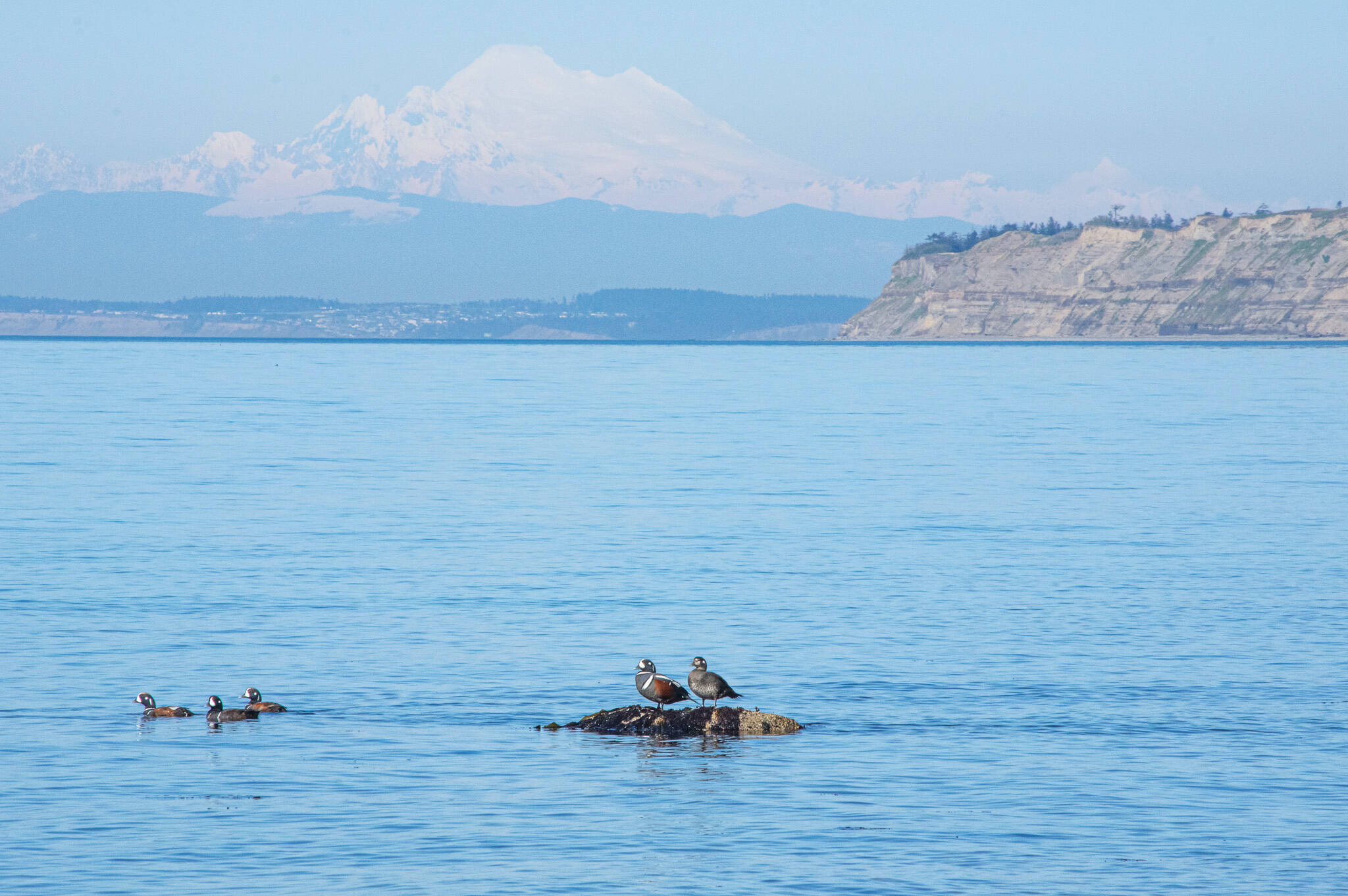Ever since the first time I saw Protection Island across the water from Sequim in the late 1990s, I’ve wondered about it. My aunt, an Audubon member, told me the largest colony of Rhinoceros Auklets in the state was on the closed-to-the-public island and described their nesting habits. I’ve been fascinated ever since.
Scott Pearson, a senior research scientist with the Washington Department of Fish and Wildlife (WDFW), said that the 379-acre federal and state wildlife sanctuary – the 10th largest Rhinoceros Auklet colony in the world – in 2008 had an estimated 36,145 occupied burrows, and that “we hope to repeat this survey in the next couple of years.”
About the island, Pearson said, “It is arguably the most important seabird nesting site in the entire Salish Sea and one of the few places with breeding tufted puffins and rhinoceros auklets.
“Plus it has a full assemblage of breeders from black oystercatchers (a shorebird) and glaucous-winged gulls (and hybrids) to pigeon guillemots, rhinoceros auklets, tufted puffins and cormorants.
“This is one of the last places where, due to lack of human activity and disturbance, these species continue to exist.”
Last fall, Pearson led a WDFW team to a vantage point above Kanam point to see the extent of a wildfire in August 2021 that burned almost 26 acres of shoreline, slope and meadow habitat before being extinguished by a multi-agency team. Their efforts were backed by a helpful wind blowing away from the interior of the island.
I was ecstatic to be included in the tour. Most of the pictures in this photo essay are from that day.
Pearson has been going to the island since 2004, as well as studying other bird populations in the sound and the coast, so he has much knowledge and wisdom to share and also has taken many gorgeous photos.
While standing confidently on a ledge of a steep slope riddled with Rhinoceros Auklet burrows over 100 feet above the shoreline, he discussed with us the effects of the fire. It was non-nesting season, as the scientists and workers who come to the island try to disturb the birds as little as possible.
Rhinoceros auklets, the oldest member of the puffin family despite their name, are more resilient to disturbance than the tufted puffins, Pearson told us. He said that scientists are constantly considering, “What are our impacts and how do we minimize them?”
An improbable-looking little bird is the face of Protection Island for many people, but according to the 2015 Washington State Status Report for the Tufted Puffin, “Historically, ornithologists considered Tufted Puffins among the most common seabirds on the Washington coast and estimated the breeding population in the tens of thousands…. More recent studies, however, point to widespread colony abandonment and a rapid order of magnitude population decline throughout Washington.”
According to Pearson, there has been just one confirmed nesting pair raising their young for the last two years on Protection. The puffins raise only one puffling at a time. The only other place in the Salish Sea/Puget sound that they nest is Smith Island, where Pearson says there are “about 27 active puffin burrows.”
The Fish and Wildlife team was also there to see the progress of a 3-acre hand-cast seeding of native plants in a burnt meadow. They hoped that the native plants would have a chance to establish themselves before the island’s common invasive plants took over.
On another occasion, I had the honor of meeting with the island’s only resident, Marty Bluewater in Cape George, who has become something of a celebrity since he is the only person to hold onto the house he built on a plot of land purchased during a push in the 1970s to turn the island into a vacation home paradise.
Like the few other buildings on the island, Bluewater’s house becomes the property of the U.S. government after he passes.
Bluewater said, “It’s all been really a dream.”
“I never expected it to be such a public part of my life, but it allowed me to meet a lot of really neat people.”
He supported the transition of the island to its federally protected status beacause, “this fragile of a place couldn’t really sustain itself with a bunch of people running around,” but he would like to see more done about the eagles and something permanent on the island to fight wildfires.
After seeing Protection Island up close, like the fortunate state and federal employees that oversee it, the scientists who document it, the last human inhabitant and his guests, I fell in love. I want to share with you some of what I saw that day and have learned since, in case you, too, are fascinated by this mysterious place which belongs to the birds.
Emily Matthiessen is a reporter with the Sequim Gazette.



